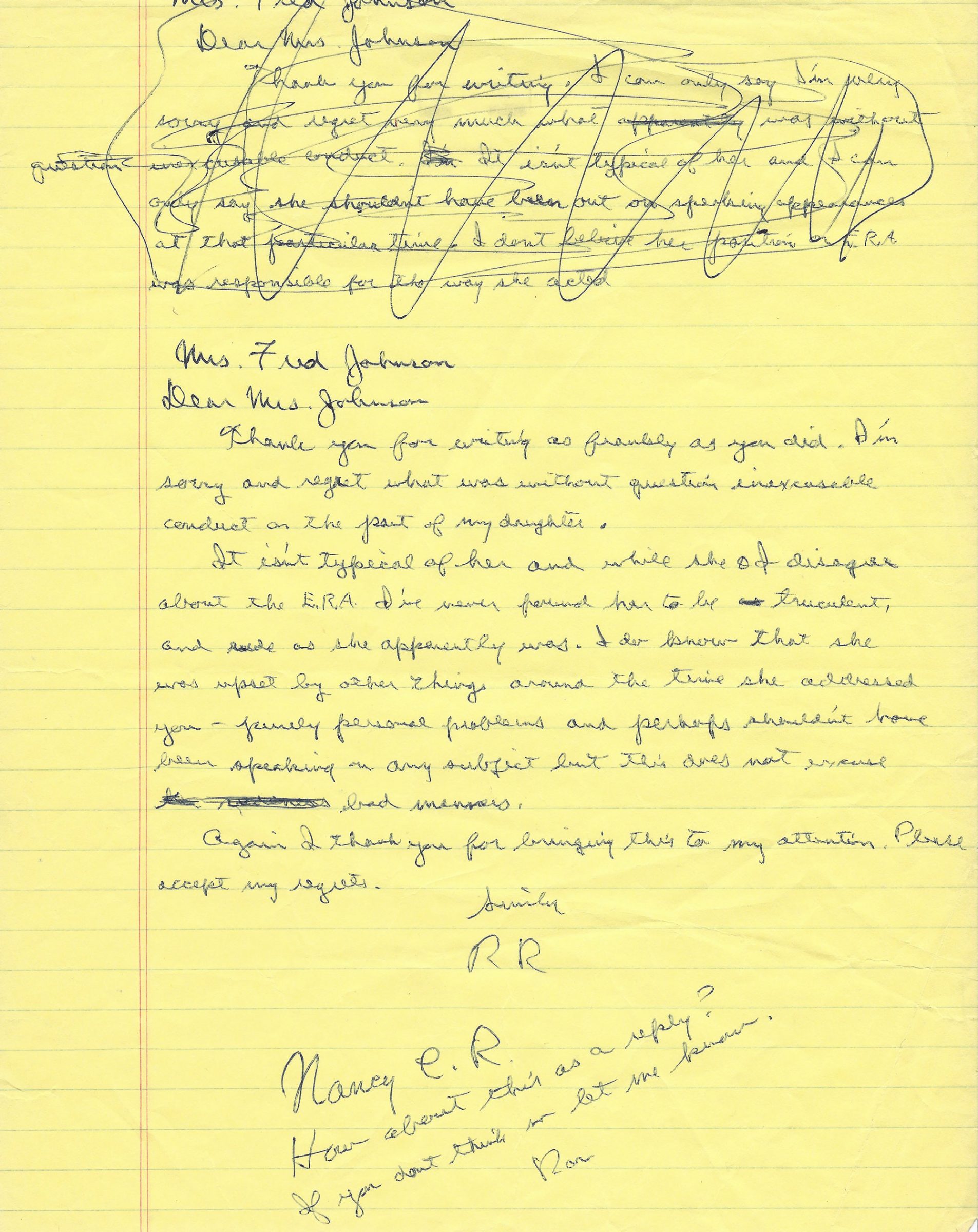Ronald Reagan Publicly Blames (and Excuses) His Daughter Patti in Their Rift Over the Equal Rights Amendment

He accepts the characterization that his daughter is rude and truculent, blames it on her personal issues, admits publicly that there are family problems, and tries to silence her by stating that she probably ought not to be speaking publicly
“I’ve never found her to be truculent, and rude as she apparently was. I do know that she was upset by other things around the time she addressed you – family personal problems and perhaps shouldn’t have been speaking on any subject…”
In 1972 Congress passed the proposed Equal Rights Amendment to...
“I’ve never found her to be truculent, and rude as she apparently was. I do know that she was upset by other things around the time she addressed you – family personal problems and perhaps shouldn’t have been speaking on any subject…”
In 1972 Congress passed the proposed Equal Rights Amendment to the U.S. Constitution. It provided, “Equality of rights under the law shall not be denied or abridged by the United States or by any State on account of sex.” The ERA still needed to be ratified by three-forth of the state legislatures. At first, there was strong public support for passage—by 1973, 30 of the necessary 38 states ratified the amendment. After 1973, however, a highly organized opposition to the ERA emerged, suggesting that ratification would prove to be detrimental to women. By 1982, the year of expiration, only 35 of the necessary 38 states voted in favor of the ERA—three states short of ratification.
Ronald Reagan was not originally opposed to the ERA, and California voted for ratification while he was governor. But in 1976 Reagan made a run at the presidency, trying to oust President Gerald R. Ford at the head of the Republican ticket. His strongest supporters opposed the ERA, and Reagan adopted their stance at that time. He would remain a foe of the ERA the rest of his life.
Reagan’s daughter Patti felt differently, and she was a public and outspoken supporter of the measure, sometimes speaking on behalf of it. This, and her opposition to many of her father’s pet positions, brought them into conflict. She became famous for her pro-choice viewpoint on abortion, and for being against nuclear weapons, and the rift between her and her parents was highly-publicized. She wrote accounts of her life that did not portray her family in a positive light, and her autobiography “The Way I See It” contained the revelations that her father was cold, distant, and aloof to everyone except Nancy, and claimed physical abuse by her mother. Yet there was love between them, and Patti eventually reconciled with her parents.
Nancy Clark Reynolds served as assistant press secretary to Reagan during his governorship of California (1967-1975), then for two years was his special assistant. When Reagan was elected president in 1980 he recruited Reynolds to join his White House transition team, and she remained a valued friend and advisor throughout his two presidential terms and beyond. Reagan appointed Reynolds US representative to the Commission on the Status of Women of the Economic and Social Council of the United Nations in September of 1981.
Draft autograph letter signed, his office in California, not dated but clearly from 1976-7 when Reynolds was his special assistant, responding to a complaint against Patti’s strong advocacy of the ERA by blaming and excusing her. The draft was sent to Reynolds for her approval before being typed up for mailing to the recipient, a Mrs. Fred Johnson. “Thank you for writing as frankly as you did. I’m sorry and regret what was without question inexcusable conduct on the part of my daughter. It isn’t typical of her and while she and I disagree about the E.R.A. I’ve never found her to be truculent, and rude as she apparently was. I do know that she was upset by other things around the time she addressed you – family personal problems and perhaps shouldn’t have been speaking on any subject, but this does not excuse bad manners. Again I thank you for bringing this to my attention. Please accept my regrets. Sincerely, RR.” Reagan then asks Reynolds, ”Nancy C.R. – How about this as a reply? If you don’t think so let me know.” We acquired the Reynolds papers, and this letter was included.
It is not known whether Reynolds approved this letter or if it was sent, but it is very revealing that Reagan could write a stranger and simply accept the characterization that his daughter was rude and truculent, then blame it on her personal issues, admit publicly that there are family problems, and try to silence her by stating that she probably ought not to be speaking publicly. One is left feeling grateful that this letter has come to light, but hoping that Reynolds advised against sending it. It contains the kinds of statements that could only have widened the rift in the family.

Frame, Display, Preserve
Each frame is custom constructed, using only proper museum archival materials. This includes:The finest frames, tailored to match the document you have chosen. These can period style, antiqued, gilded, wood, etc. Fabric mats, including silk and satin, as well as museum mat board with hand painted bevels. Attachment of the document to the matting to ensure its protection. This "hinging" is done according to archival standards. Protective "glass," or Tru Vue Optium Acrylic glazing, which is shatter resistant, 99% UV protective, and anti-reflective. You benefit from our decades of experience in designing and creating beautiful, compelling, and protective framed historical documents.
Learn more about our Framing Services







































































































